Why Wild Venison Is a Sustainable Meat
by Robert Gooch April 28 2021
Looking for a sustainable and nutritious meat to include in a climate-friendly diet? Look no further than delicious British wild venison!
As concerns about climate change continue to grow, it’s clear major lifestyle changes are needed if the UK is to meet the government’s reduced emission target of a 78% reduction on 1990 levels by 2035. Could eating lean and healthy wild venison be the answer to keeping meat in our diets while reducing our carbon footprint?

photograph ©Miles Cook, Glorious Game published by Face Publications
The planet-friendly meat
While many variables have to be taken into account when estimating the carbon footprints of farmed meats (including what animals have been fed, how farms use electricity and fossil fuels, how far animals are transported for slaughtering, and how efficiently butchers and retailers use electricity), the calculations of farmed meats are invariably higher than those for game. The Carbon Food Calculator on the Vegan Society’s website, for example, suggests game meat is responsible for 6.53kg CO2e/kg, which is less than a third of untrimmed beef’s 23.43kg CO2e/kg. It’s also significantly less than cheese, which is said to be responsible for 12.27kg CO2e/kg, meaning swapping a beef burger for a wild venison burger is a more climate-friendly option than opting for halloumi or a vegetarian option with cheese.
The UK’s deer population
When the Deer Commission for Scotland investigated the carbon cost of wild venison, they noted that 76% of the total emissions associated with wild venison were linked to the methane emitted by deer. However, it’s important to note that deciding against eating wild venison won’t stop deer producing methane! In fact, quite the opposite. Not eating wild venison means that Britain’s ever-growing population of deer will continue to grow and emit more emissions into the atmosphere. Regularly eating wild venison, on the other hand, makes it worthwhile for deer stalkers like Truly Traceable’s Steve Tricker to provide his vital deer management services to farms and estates in exchange for being able to keep and sell the carcasses.
If nobody ate wild venison, it would still be necessary for Steve and other deerstalkers to cull a percentage of the UK’s deer population each year, though. The UK’s deer population has reached such large numbers that it’s become essential to manage them to protect affected flora and fauna in our country’s woodlands, as well as the crops that feed us all. Apex predators (such as wolves, bears and lynx) historically kept deer populations in check but these predators are no longer part of the UK ecosystem. Some re-wilding projects are trying to bring them back but, until that happens, humans are deer’s only predator. This is why populations of non-native species, including muntjac and Chinese water deer, have also gained strong footholds in the UK alongside our native species – and why culling is vital to help redress the balance. Rotting food is a huge contributor to greenhouse gas emissions and not eating the wild venison meat from culled deer would produce substantial emissions, while a wonderful nutritious food source went to waste.

Wild versus farmed
Some supermarkets sell farmed venison, including venison that has been shipped over all the way from New Zealand! Shipping venison over seems like madness to us when all around us in Suffolk we are surrounded by an abundant wild source. While farmed deer will graze pastures in the warmer months, they need supplementary feeds like hay and silage in the winter in New Zealand or the UK, and this comes with a significant carbon cost. Add in the emissions associated with shipping meat from New Zealand and you can see that farmed venison – especially New Zealand farmed venison – is not nearly as environmentally friendly as wild venison.
Good for you and the planet
When considering how sustainable a meat is, it’s also important to take into account its nutritional benefits. A diet is only sustainable if it’s healthy and, gram for gram, wild venison provides more protein than any other red meat. A single serving provides about a third of the recommended daily allowance of iron, while beef provides less than a quarter. It’s also high in B vitamins, including B2 (riboflavin) and B3 (niacin), which help to regulate the metabolism, and B6 and B12, which are thought to help lower homocysteine levels and help prevent heart attacks and strokes.
What’s more, it’s low in fat so is less likely to contribute to weight gain and its associated health problems. Wild venison contains just 1% fat, which is substantially less than lamb at 10%, beef at 11%, halloumi at 25%, and Beyond Meat’s vegan sausages at 16%.
Quality over quantity
If you’d like to include wild venison as part of a healthy diet, its delicious rich flavour means a little goes a long way. Casseroles, stir fries, chilli con carnes, curries and other meals are delicious when made with just a little wild venison and lots of healthy vegetables and pulses. Use wild venison mince in place of beef mince or one of the other products in our venison range in your favourite recipes – or browse our wild venison recipes for more ideas.


